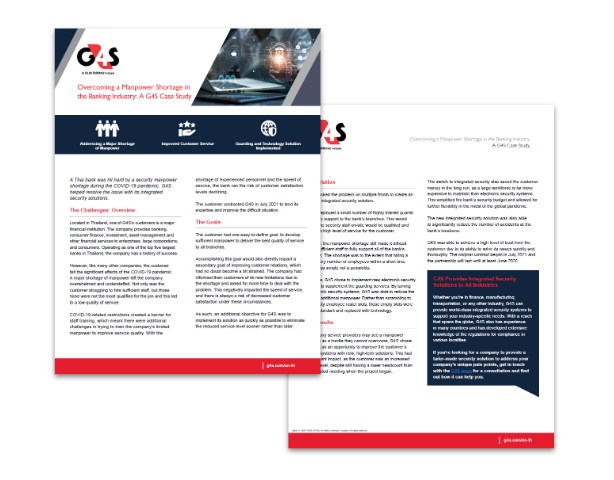Overcoming a Manpower Shortage

THE CHALLENGES: OVERVIEW
Located in Thailand, one of G4S’s customers is a major financial institution. The company provides banking, consumer finance, investment, asset management and other financial services to enterprises, large corporations, and consumers. Operating as one of the top five largest banks in Thailand, the company has a history of success.
However, like many other companies, the customer felt the significant effects of the COVID-19 pandemic. A major shortage of manpower left the company overwhelmed and understaffed. Not only was the customer struggling to hire sufficient staff, but those hired were not the most qualified for the job and this led to a low quality of service.
COVID-19-related restrictions created a barrier for staff training, which meant there were additional challenges in trying to train the company’s limited manpower to improve service quality. With the shortage of experienced personnel and the speed of service, the bank ran the risk of customer satisfaction levels declining. The customer contracted G4S in July 2021 to lend its expertise and improve the difficult situation.
THE GOALS
The customer had one easy-to-define goal: to develop sufficient manpower to deliver the best quality of service to all branches.
Accomplishing this goal would also directly impact a secondary goal of improving customer relations, which had no doubt become a bit strained. The company had informed their customers of its new limitations due to the shortage and asked for more time to deal with the problem. This negatively impacted the speed of service, and there is always a risk of decreased customer satisfaction under these circumstances.
As such, an additional objective for G4S was to implement its solution as quickly as possible to eliminate the reduced service level sooner rather than later.
THE SOLUTION
G4S attacked the problem on multiple fronts to create an effective integrated security solution. First, it deployed a small number of highly trained guards to provide support to the bank’s branches. This would ensure the security staff on-site would be qualified and provide a high level of service for the customer. However, the manpower shortage still made it difficult to hire sufficient staff to fully support all of the bank’s branches. The shortage was to the extent that hiring a satisfactory number of employees within a short time period was simply not a possibility.
Therefore, G4S chose to implement new electronic security systems to supplement the guarding services. By turning to electronic security systems, G4S was able to reduce the need for additional manpower. Rather than scrambling to fulfill empty employee roster slots, those empty slots were made redundant and replaced with technology.
THE RESULTS
While many service providers may see a manpower shortage as a hurdle they cannot overcome, G4S chose to view it as an opportunity to improve the customer’s security systems with new, high- tech solutions. This had a significant impact, as the customer saw an increased service level, despite still having a lower headcount than it anticipated needing when the project began.
The switch to integrated security also saved the customer money in the long run, as a large workforce is far more expensive to maintain than electronic security systems. This simplified the bank’s security budget and allowed for further flexibility in the midst of the global pandemic. The new integrated security solution was also able to significantly reduce the number of accidents at the bank’s locations.
G4S was able to achieve a high level of trust from the customer due to its ability to solve its issues quickly and thoroughly. The original contract began in July 2021 and the partnership will last until at least June 2026.
DOWNLOAD THE PDF CASE STUDY
If you would like this case study in PDF, please complete the form to gain access.

